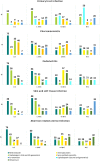Aetiology and use of antibiotics in pregnancy-related infections: results of the WHO Global Maternal Sepsis Study (GLOSS), 1-week inception cohort
- PMID: 38402175
- PMCID: PMC10894467
- DOI: 10.1186/s12941-024-00681-8
Aetiology and use of antibiotics in pregnancy-related infections: results of the WHO Global Maternal Sepsis Study (GLOSS), 1-week inception cohort
Abstract
Background: Pregnancy-related infections are important contributors to maternal sepsis and mortality. We aimed to describe clinical, microbiological characteristics and use of antibiotics by source of infection and country income, among hospitalized women with suspected or confirmed pregnancy-related infections.
Methods: We used data from WHO Global Maternal Sepsis Study (GLOSS) on maternal infections in hospitalized women, in 52 low-middle- and high-income countries conducted between November 28th and December 4th, 2017, to describe the frequencies and medians of maternal demographic, obstetric, and clinical characteristics and outcomes, methods of infection diagnosis and causative pathogens, of single source pregnancy-related infection, other than breast, and initial use of therapeutic antibiotics. We included 1456 women.
Results: We found infections of the genital (n = 745/1456, 51.2%) and the urinary tracts (UTI) (n = 531/1456, 36.5%) to be the most frequent. UTI (n = 339/531, 63.8%) and post-caesarean skin and soft tissue infections (SSTI) (n = 99/180, 55.0%) were the sources with more culture samples taken and microbiological confirmations. Escherichia coli was the major uropathogen (n = 103/118, 87.3%) and Staphylococcus aureus (n = 21/44, 47.7%) was the commonest pathogen in SSTI. For 13.1% (n = 191) of women, antibiotics were not prescribed on the same day of infection suspicion. Cephalosporins (n = 283/531, 53.3%) were the commonest antibiotic class prescribed for UTI, while metronidazole (n = 303/925, 32.8%) was the most prescribed for all other sources. Ceftriaxone with metronidazole was the commonest combination for the genital tract (n = 98/745, 13.2%) and SSTI (n = 22/180, 12.2%). Metronidazole (n = 137/235, 58.3%) was the most prescribed antibiotic in low-income countries while cephalosporins and co-amoxiclav (n = 129/186, 69.4%) were more commonly prescribed in high-income countries.
Conclusions: Differences in antibiotics used across countries could be due to availability, local guidelines, prescribing culture, cost, and access to microbiology laboratory, despite having found similar sources and pathogens as previous studies. Better dissemination of recommendations in line with antimicrobial stewardship programmes might improve antibiotic prescription.
Keywords: Antibiotic; Infections; Maternal morbidity; Maternal sepsis.
© 2024. The Author(s).
Conflict of interest statement
The authors declare that they have no competing interests. The collaboration between The Human Reproduction Programme, Department of Sexual and Reproductive Health and Research and Merck for Mothers is governed by a bilateral agreement. The authors alone are responsible for the views expressed in this article and they do not necessarily represent the views, decisions or policies of the institutions with which they are affiliated.
Figures



References
-
- WHO. The WHO application of ICD-10 to deaths during pregnancy, childbirth and puerperium: ICD MM. World Health Organization, Geneva, Switzerland, 2012. https://apps.who.int/iris/bitstream/handle/10665/70929/9789241548458_eng.... Accessed 12 Sept 2023.
-
- Roth GA, Abate D, Abate KH, et al. Global, regional, and national age-sex-specific mortality for 282 causes of death in 195 countries and territories, 1980–2017: a systematic analysis for the Global Burden of Disease Study 2017. Lancet. 2018;392:1736–1788. doi: 10.1016/S0140-6736(18)32203-7. - DOI - PMC - PubMed

